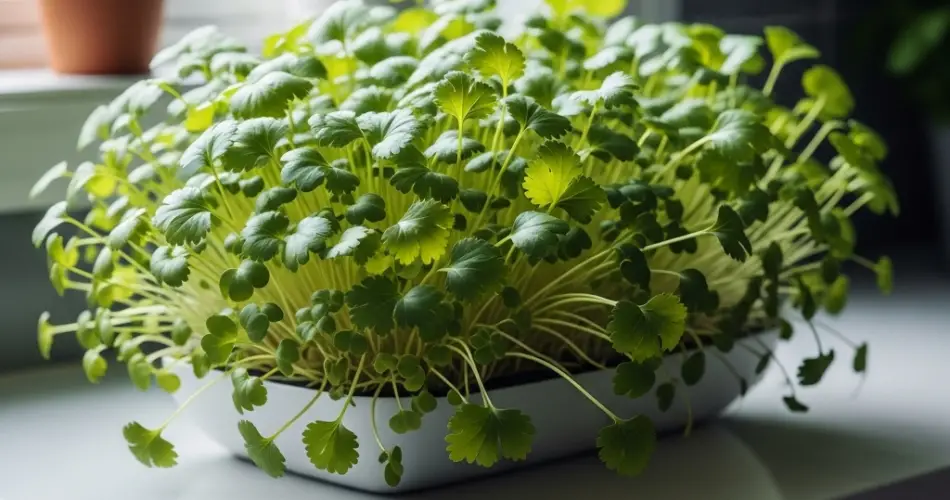Coriander microgreens are packed with intense flavor and vibrant nutrients, making them a fantastic addition to salads, sandwiches, soups, and smoothies. Growing them at home is easier than you might think, and you don’t need a large garden or even a balcony. With just a few basic supplies, you can grow fresh coriander microgreens right on your kitchen countertop. Here’s a simple, step-by-step guide to help you succeed.
Why Grow Coriander Microgreens?
Coriander, also known as cilantro, is valued not only for its distinct taste but also for its health benefits. As microgreens, they contain higher concentrations of vitamins and antioxidants than mature leaves. Since they are harvested early—usually within 14 to 21 days—they’re an excellent choice for anyone looking to boost their diet with fresh greens without waiting months for harvest.
What You’ll Need
To grow coriander microgreens on your countertop, gather the following:
-
Coriander seeds (whole, not split)
-
A shallow growing tray or container with drainage holes
-
A second tray without holes to catch excess water
-
Seed-starting soil mix or coconut coir
-
Spray bottle for misting
-
Plastic wrap or humidity dome (optional)
-
Natural light or a grow light
Choose organic seeds if possible, and avoid any pre-treated or chemically coated varieties. For containers, even repurposed takeout trays or baking pans work well, as long as they’re clean and have holes for drainage.
Step 1: Prepare the Seeds
Coriander seeds are actually two seeds in one husk, so gently crushing them slightly increases germination success. You can do this with a rolling pin or by rubbing them between your hands. Once cracked, soak the seeds in water for 6–8 hours or overnight. This helps soften the shell and jumpstarts the germination process.
Step 2: Set Up the Growing Tray
Fill your tray with a 1–2 inch layer of moist seed-starting mix or coconut coir. Smooth the surface evenly and gently press it down. Avoid compacting it too much—roots need some air to grow.
After draining the soaked seeds, scatter them evenly over the surface of the soil. You don’t need to bury them. Coriander seeds grow well when they’re just gently pressed into the surface. Mist the seeds lightly with a spray bottle to keep them moist.
Step 3: Cover and Germinate
To encourage germination, cover the tray with plastic wrap, a humidity dome, or another tray to keep in moisture and warmth. Place the covered tray in a warm, dark place such as a cupboard or pantry for 2–4 days. Check daily to ensure the seeds remain moist but not soggy. If the surface starts drying out, lightly mist again.
After a few days, you’ll notice tiny white roots appearing. This is your signal to move the tray into the light.
Step 4: Light and Growth
Once sprouted, uncover the tray and move it to a bright spot on your countertop—preferably where it gets indirect sunlight for several hours a day. If natural light is limited, a simple LED grow light will do the trick.
Continue to mist the soil daily, but avoid overwatering. The goal is to keep the soil moist but not waterlogged. Excessive moisture can lead to mold or root rot. If your tray has a bottom container, ensure there’s no standing water left after watering.
Step 5: Harvesting
Coriander microgreens are typically ready to harvest within 14 to 21 days, depending on light and temperature conditions. You’ll know they’re ready when the first set of true leaves (the second pair of leaves) starts to form.
Use clean scissors to snip the greens just above the soil line. Harvest all at once or cut what you need and let the rest keep growing. For the best flavor, harvest in the morning when the greens are most hydrated.
Storing and Using Microgreens
Coriander microgreens are best eaten fresh but can be stored in the refrigerator for up to a week. After harvesting, gently pat them dry, place them in an airtight container lined with a paper towel, and refrigerate. Do not wash until just before use to extend shelf life.
Add them as a garnish, blend into green sauces, or toss into wraps and tacos. Their bright, citrusy flavor elevates even the simplest meals.
Final Tips
-
Air circulation is important. If your kitchen is humid, consider placing a small fan nearby to reduce the risk of mold.
-
Avoid direct midday sun, especially through glass, as it may scorch delicate seedlings.
-
Sanitize containers before each new planting to prevent disease.
Growing coriander microgreens is not only easy but also incredibly rewarding. With minimal space and effort, you can enjoy homegrown greens year-round, right from your countertop.



